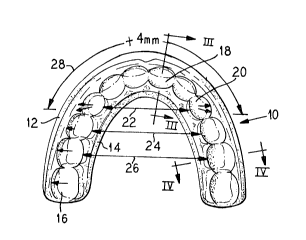Some of the information on this Web page has been provided by external sources. The Government of Canada is not responsible for the accuracy, reliability or currency of the information supplied by external sources. Users wishing to rely upon this information should consult directly with the source of the information. Content provided by external sources is not subject to official languages, privacy and accessibility requirements.
Any discrepancies in the text and image of the Claims and Abstract are due to differing posting times. Text of the Claims and Abstract are posted:
| (12) Patent: | (11) CA 2009440 |
|---|---|
| (54) English Title: | DENTAL-FORM EXPANSION APPLIANCE |
| (54) French Title: | APPAREIL ORTHODONTIQUE D'EXPANSION |
| Status: | Deemed expired |
| (52) Canadian Patent Classification (CPC): |
|
|---|---|
| (51) International Patent Classification (IPC): |
|
| (72) Inventors : |
|
| (73) Owners : |
|
| (71) Applicants : | |
| (74) Agent: | CASSAN MACLEAN |
| (74) Associate agent: | |
| (45) Issued: | 1994-03-15 |
| (22) Filed Date: | 1990-02-06 |
| (41) Open to Public Inspection: | 1991-08-06 |
| Examination requested: | 1991-04-29 |
| Availability of licence: | N/A |
| (25) Language of filing: | English |
| Patent Cooperation Treaty (PCT): | No |
|---|
| (30) Application Priority Data: | None |
|---|
ABSTRACT OF THE DISCLOSURE
An orthodontic appliance is provided which has
upper and lower tooth receiving troughs which include
sockets for the canines and posterior teeth, the
sockets being laterally spaced at a distance greater
than the normal lateral spacing of the patient's
posterior teeth, and a mesio-distal dimension of the
canine sockets is greater than the normal mesio-distal
dimension of the patient's canines to provide
expansion in a deciduous or mixed dentition.
Note: Claims are shown in the official language in which they were submitted.
Note: Descriptions are shown in the official language in which they were submitted.

For a clearer understanding of the status of the application/patent presented on this page, the site Disclaimer , as well as the definitions for Patent , Administrative Status , Maintenance Fee and Payment History should be consulted.
| Title | Date |
|---|---|
| Forecasted Issue Date | 1994-03-15 |
| (22) Filed | 1990-02-06 |
| Examination Requested | 1991-04-29 |
| (41) Open to Public Inspection | 1991-08-06 |
| (45) Issued | 1994-03-15 |
| Deemed Expired | 2004-02-06 |
There is no abandonment history.
| Fee Type | Anniversary Year | Due Date | Amount Paid | Paid Date |
|---|---|---|---|---|
| Application Fee | $0.00 | 1990-02-06 | ||
| Maintenance Fee - Application - New Act | 2 | 1992-02-06 | $50.00 | 1992-01-23 |
| Maintenance Fee - Application - New Act | 3 | 1993-02-08 | $50.00 | 1993-01-18 |
| Maintenance Fee - Application - New Act | 4 | 1994-02-07 | $50.00 | 1994-02-04 |
| Maintenance Fee - Patent - New Act | 5 | 1995-02-06 | $75.00 | 1995-01-19 |
| Maintenance Fee - Patent - New Act | 6 | 1996-02-06 | $75.00 | 1996-01-18 |
| Maintenance Fee - Patent - New Act | 7 | 1997-02-06 | $75.00 | 1997-01-20 |
| Maintenance Fee - Patent - New Act | 8 | 1998-02-06 | $75.00 | 1998-01-20 |
| Maintenance Fee - Patent - New Act | 9 | 1999-02-08 | $75.00 | 1999-01-19 |
| Maintenance Fee - Patent - New Act | 10 | 2000-02-07 | $300.00 | 2000-02-14 |
| Maintenance Fee - Patent - New Act | 11 | 2001-02-06 | $100.00 | 2001-01-18 |
| Maintenance Fee - Patent - New Act | 12 | 2002-02-06 | $100.00 | 2002-01-17 |
| Registration of a document - section 124 | $100.00 | 2004-01-07 |
Note: Records showing the ownership history in alphabetical order.
| Current Owners on Record |
|---|
| ORTHO-TAIN, INC. |
| Past Owners on Record |
|---|
| BERGERSEN, EARL O. |